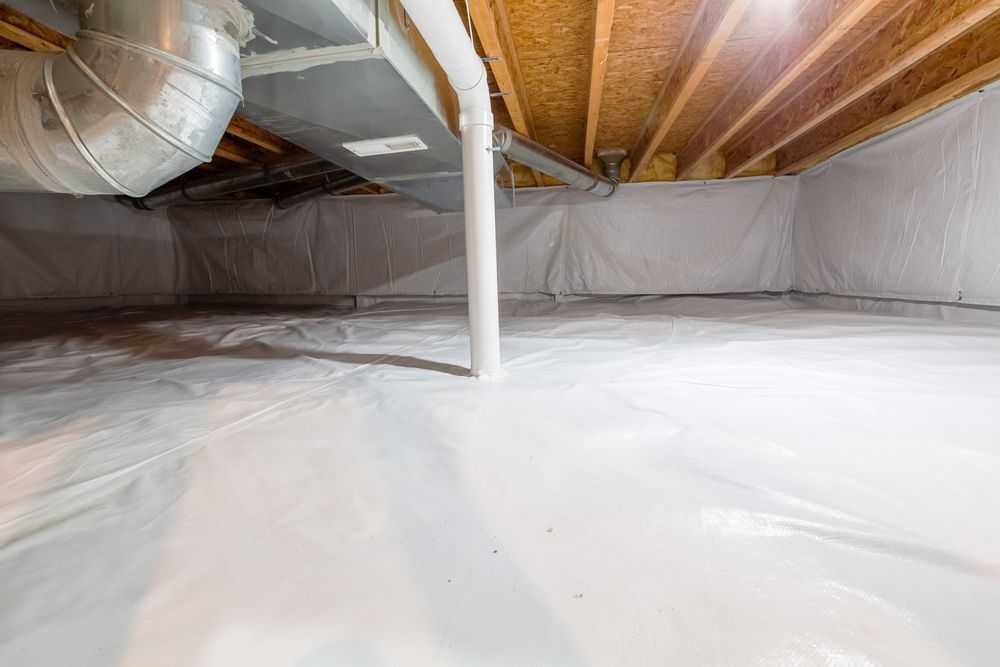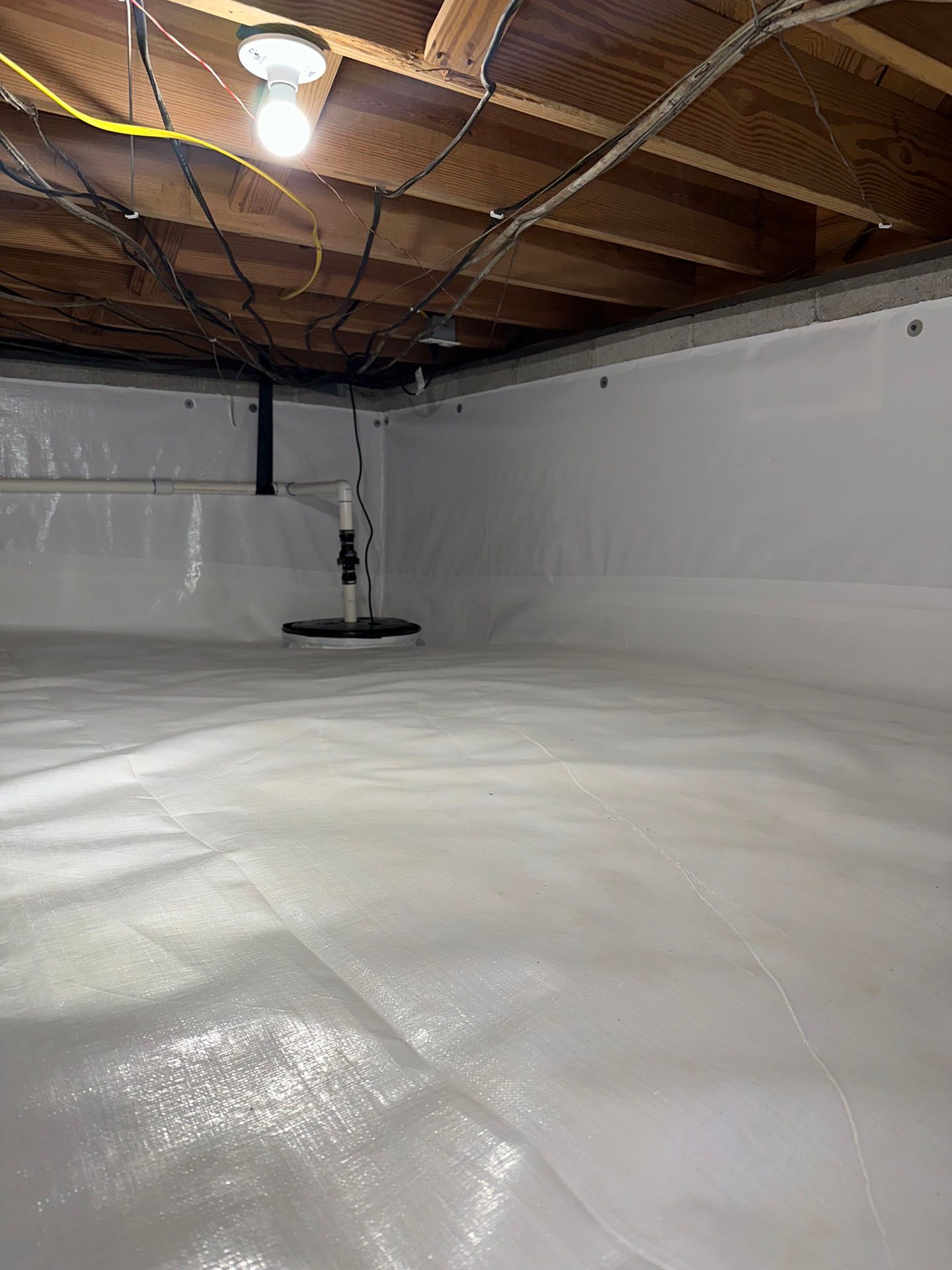Huntsville, Alabama

Claim Your FREE Crawl Space Inspection Today!
Sawyer Williams: 256-727-4422
Schedule Your Free estimate!
No-Obligation, Free Inspections
No-Obligation Free Estimates
We Warranty All of Our Work
100% Satisfaction Guaranteed
So you've come across a less than ideal situation - water in your crawl space. Suddenly, you're thinking of all the terrible things that can happen as a result of moisture and flooding in your property - but don't panic just yet! While this certainly isn't an issue to take lightly, there are steps you can take to ensure that your crawl space stays dry and protected, so that it can continue to play its part in preserving the structural integrity of your home. In this blog post, we'll explore what you need to know about how to deal with water in your crawl space. From identifying the source of water to preventing and repairing damage, we've got you covered. So, take a deep breath, get your rubber boots on, and let's get started.
Quick Explanation of Key Question
Before attempting to clean up the water in your crawl space, you should identify the source of the leak. Depending on the severity, you may need professional help to fix the problem and complete the cleanup.
Inspect the Crawl Space
In order to effectively deal with water in your crawl space, it is essential to start by inspecting the space thoroughly. Start by taking note of the current condition of the interior walls, floors and any other areas that could easily flood due to water intrusion. Any structural damage should be noted and addressed as soon as possible.
It is also important to check for signs of pests, such as small colonies of ants or termites. Make sure to look for any evidence of leaky pipes or clogged drainage systems. This can be done by visually inspecting all accessible pipes and drains, as well as checking for water stains or rot on the interior walls and floors of the crawl space.
Additionally, inspect the exterior walls for any indications that there is water present in this area. Look for cracks or gaps in the foundation which could potentially let in water and moisture into your crawl space. It is also a good idea to check around windows, doors and gutters for any signs that there may be an issue with drainage or leaking water.
Lastly, it is important to check the insulation in your crawl space to ensure that it is still in good condition and working properly to help keep moisture levels low within the space. Any insulation that has become damaged over time should be replaced, as this could lead to an increase in moisture within your crawl space which will only add to the potential water intrusion issues.
Now that you have inspected your crawl space and taken note of any potential problems, it’s time to move on to the next step: identify the source(s) of water entering your crawl space.
- According to the Centers for Disease Control, exposed soil and standing water create an ideal environment for mold and mildew growth, which can cause serious health problems such as respiratory issues, skin irritation, headaches, fatigue, and other ailments.
- A study published by the National Center for Biotechnology Information found that certain types of mold may produce myotoxins and neurotoxins which can cause systemic health problems when inhaled or ingested.
- According to a study published in the Journal of Environmental Health, long term exposure to excess dampness can increase the risk of developing asthma.
Top Points to Remember
In order to properly deal with water in a crawl space, it is important to inspect the space thoroughly and look for signs of pests, leaky pipes or clogged drainage systems, cracks or gaps in the foundation, and damaged insulation. After inspection, it is necessary to identify the source(s) of water entering the crawl space to help prevent future water intrusion issues.
Identify the Source of Water
Identifying the source of water in a crawl space is essential to determining the appropriate course of action. The cause can typically be divided into natural sources and man-made sources.
Natural sources include excess water that infiltrates the space through foundation walls, leaky windows, or breaches in flashings; all stemming from the environment outside the home. The most common man-made sources are related to plumbing issues such as leaking pipes, overflowing drains, inadequate drainage systems, and lateral flooding.
To determine where the water is coming from, property owners should take note of any patterns, smells or visible growth in the area. It may be helpful to look for clues such as wet spots on floor joists near plumbing fixtures, odor from backed up sewage lines, mold growth, standing water, or increased humidity levels. If no clues can be found, it may be necessary to contact a professional for help detecting subtle signs of moisture. Property owners should also consider factors such as recent rainfalls, slope of their property and proximity to nearby bodies of water when diagnosing the causes of water intrusion.
Once the source is identified, you’re ready to move on and check for leaks, flooding and pipe issues in your crawl space.
Check for Leaks, Flooding, and Pipe Issues
Checking for leaks, flooding, and pipe issues is a key part of proper maintenance for your crawl space and can help to prevent long-term water damage. To properly inspect the area, look for any signs of water damage in the form of standing water, mold, or moisture on walls or floors.
Additionally, check around the pipes and plumbing fixtures for any wet spots or condensed areas that could indicate a leak or overworking pipe. Pay special attention to any areas where there is insulation. If insulation is soaked, it could be a sign of a leaking pipe or condensation build-up from high humidity levels in the air.
If any evidence of a leak or flooding is observed, it's important to seek professional assistance as soon as possible and have the issue addressed before further damage occurs. A professional can help determine the cause of the leak and provide guidance on how to best remedy the situation if repair work is necessary. This may include replacing damaged pipes and seals, relocating vulnerable appliances away from flood zones, or adding additional insulation to block potential moisture buildup.
On the other hand, if no signs of leakage or flooding are found during inspection, it's still beneficial to take extra precautionary measures such as proactively checking the dryness of the foundation around all plumbing fixtures on regular intervals. Doing so regularly can help you catch any ongoing issues before they become bigger problems later on.
Now that we have discussed checking for leaks, flooding, and pipe issues in your crawl space; let's move on to discuss monitor moisture levels in our next section.
Monitor Moisture Levels
Monitoring the moisture levels in your crawl space is a vital part of keeping it in good condition. A number of tools can be used to measure humidity and moisture, giving you an accurate overview of the environment. It’s important to check the levels regularly, ideally monthly or after periods of high rainfall.
The most commonly used device for monitoring moisture is a hygrometer. This tool can quickly and accurately measure the relative humidity in your crawl space. It’s cost-effective and easy to use, making it a good choice for many homeowners. Other devices such as data loggers can provide more detailed information about the conditions over longer time periods. A data logger doesn't need to be checked daily, but does provide a deeper understanding atmospheric conditions within and around your home.
It's wise to add regular inspections by a professional contractor or waterproofing specialist to your monitoring regime. They will be able to assess not just the current moisture levels, but any signs of damage that may require repair. Additionally they may want to take samples and send them off for mold testing, which can highlight any areas that need urgent attention.
Arguments have been made for both sides when it comes to if regular consultations are actually necessary; on one hand there is the argument that preventive measures should always be taken through monthly checks, while on other hand it can be argued that inspecting too much might cause unnecessary disruption or cost. In any case, negligence or improper handling will likely worsen the issue or cause further damage in the long run, so proper care should always be taken when monitoring moisture levels in your crawl space.
With regular checks and inspections come not just peace of mind but also better preparedness for dealing with any problems as soon as possible before more involved steps are needed - like dehumidification and water proofing systems - so now having discussed how best to monitor moisture levels in your crawl space, let us move on to how best handle moisture and humidity within your home in the next section.
Handle Moisture and Humidity
Careful management of moisture and humidity levels is essential for preventing water damage and other issues in your crawl space. High levels of moisture and humidity can cause mold, rot, and a host of structural problems. On the other hand, some moisture can actually be beneficial for both building materials and the environment around them.
When considering how to manage the moisture and humidity in your crawl space, it is important to strike the right balance between too wet and too dry. To determine where on the scale you should aim for, you will need to consider the type of home you are dealing with as well as its geographic location and climate. For example, homes located in areas with high levels of rainfall or humid climates will typically require more advanced approaches than dryer regions with less rainfall or cooler temperatures that experience fewer environmental changes throughout the year.
The most effective way to maintain an appropriate level of humidity in your crawl space is through a dehumidification system. This type of system actively removes moisture from the air using mechanical or chemical processes, resulting in dryer air inside the confined area. While this approach can take some time and effort to set up and maintain, it may be worth it in the long run if it helps prevent costly water damage down the road. Another strategy you might employ is installing vapor barriers along walls and floors; this prevents moisture from entering from outside sources, but does not address any existing issue already present in the crawl space.
In terms of managing too much moisture, proper ventilation can help allow damp air to escape before causing issues, although there are many other drainage strategies available depending on your home’s design. For instance, pumps as well as gravity drains are both capable of helping remove excess standing liquid from an area quickly before it has a chance to cause harm.
Keeping your crawl space at an appropriate level of humidity combined with timely drainage solution implementation should help keep your living space dry and damage-free. To learn more about how to install pumps and drains into your crawl space, please read on to our next section.
Install Pumps and Drains
The installation of pumps and drains is an essential component in managing the water levels in your crawl space. Properly installed pumps and drains can help direct water away from your crawlspace, protecting it from mold and other serious damage related to flooding. This solution is especially useful if you are unable to eliminate the sources of the water coming into your crawl space.
For a pump solution, sump pumps can be placed in the lowest part of the crawl space and drain any standing water left after rain or high water tables. Just be sure that you do not place the pump in such a way that it affects whatever is stored in the crawlspace, such as cardboard boxes. Additionally, installing a secondary back-up battery powered pumps may be necessary since power outages could leave non-battery operated pumps stranded during heavy rains and flooding.
A drain solution can also be implemented for collecting pooled water or infiltrating ground water, carrying it to an exterior location or sump crock. Consider installing a(n) drain tile & pipe, curtain drain, or footing drain depending on your preferred deep to direct incoming fluid away from your home. In some instances this system can be intricate and it should not be attempted as a DIY project under any circumstances; you should always hire a qualified contractor with drainage solutions experience to properly install pumps and drains around your home, in order to guarantee optimal results with minimal long-term maintenance costs down the road.
It's important to remember that pumps and drains should only ever be used as temporary fixes for your flood issue in order to prevent further damage. Although installing pumps and drains can temporarily help mitigate the effects of flooding, repairing any physical damage caused by floods is still recommended in order to prevent future flooding incidents within your home's crawlspace. With that being said, let's turn our attention to how we might go about repairing any damage caused by flooding in our next section.
Repair any Damage
Once you have located the source of water in your crawl space, it is essential that the damage is repaired as quickly as possible. Whether this means repairing a plumbing issue, fixing a broken window, or filling in holes in the foundation walls, the sooner these repairs are made, the less likely additional problems will occur.
However, when it comes to making long-term repairs in your crawl space, you must consider both sides of the argument. On one hand, making repairs and reinforcing your home’s structure can help prevent future issues. However, depending on the severity of damage or water infiltration, these repairs and improvements can be quite expensive. In some cases, it may be worth investing in and taking the time to complete more comprehensive structural repairs than just a simple fix.
Ultimately, homeowners should weigh their options carefully and decide what makes sense for them and their budget.
Now that you have addressed any necessary repairs to improve drainage or reinforce your home’s structure from further damage due to ongoing water infiltration, it is time to clean up and prevent further issues down the road.
Clean Up and Prevent Future Issues
The next step after assessing the problem is to take proactive measures in addressing and hopefully preventing future water related issues. There are a variety of methods for cleaning up existing water in your crawl space and preventing additional flooding.
Water Extraction
Using specialized equipment, such as wet-dry vacs or sump pumps, can be effective in extracting large amounts of standing water from a crawl space. If rental equipment is not available, professional services may be necessary to safely and efficiently remove.
Dehumidification
Maintaining an appropriate level of humidity in a crawl space is key to preventing excessive amounts of water from accumulating. An indoor relative humidity of around 50% should be the goal, as this provides enough air flow to prevent moisture buildups without making interior areas too dry. Dehumidifiers can be used to help maintain optimum humidity levels by drawing excess moisture out of the air and filtering it through a condensate pan which empties into a drain or other collection system. Dehumidification also helps reduce the potential for mold or mildew issues caused by lingering moisture.
Drainage System Installation
In addition to dehumidification, the installation of a drainage system can help control or eliminate water accumulation issues in the crawl space. French drains or perimeter drain systems can be installed around the perimeter of a structure in order to collect surface water and divert it away from its foundation before it has a chance to seep into any cracks or gaps at ground level. Gutter systems can also be extended so that rainwater from your roof is channelled away from vulnerable areas that could become susceptible to standing water buildups.
Moisture Barriers Installation
The installation of moisture barriers, usually constructed from plastic sheeting, is another way to prevent existing groundwater from entering your crawl space. The barriers should extend up the walls and cover the entire floor area with a few inches overlap on all edges and seams sealed securely with caulk or mastic. This will form an effective shield against rising moisture while still allowing vapor transmission which reduces condensation buildup due to ambient humidity – provided an appropriate dehumidifier is present in the area. Additionally, caulking any visible cracks along ‘hard’ surfaces such as concrete walls or flooring will further protect against potential infiltration points should there ever be heavy rains or flooding situations.
Repair Structural Damage
If any structural damage has been discovered during your assessment period, steps may need to be taken quickly in order to address any concerns before they have a chance worsen over time. In some cases, even relatively minor damage may need specialized attention if cracks or other openings exposing interior spaces appear present after subsurface water has been removed from the area. If necessary, hiring a licensed contractor who is familiar with foundation repair techniques may be necessary for more serious cases involving compromised foundations due to extreme weather exposure overtime.
Conclusion
By taking proactive steps towards monitoring and controlling moisture levels in and around your home’s crawlspace environment, you can contribute significantly towards protecting your property and reducing long-term maintenance costs that result from unchecked water buildups or other potentially damaging conditions brought on by excess humidity levels over time.
Frequently Asked Questions and Answers
What are the potential sources of water in a crawl space?
There are several potential sources of water in a crawl space. The most common source is ground water due to excessive rain or flooding. In addition, there may be plumbing leaks, or condensation from unvented ventilation systems. In some cases, melting snow or ice on the roof may seep into a crawl space. Lastly, if a home has poor drainage systems, it can lead to standing water and/or surface flooding in a crawl space as well.
It is important to identify the source of water in order to effectively deal with it and prevent damage to the structure of the home and furniture within it. Groundwater should be redirected away from the home with proper gutters and downspouts, and sealed walls should help keep surface water out of the home. Potential leaks from plumbing should be checked for and repaired as needed, and any ventilation that does not adequately ventilate moisture should be corrected.
How can I reduce the risk of water intrusion in a crawl space?
To reduce the risk of water intrusion in a crawl space, it is important to take preventive measures such as:
1. Install a sealed vapor barrier on the floor of the crawl space, ensuring that all seams and edges are taped firmly to the walls and other surfaces. This will help keep moisture out and also make it easier to inspect the area for any water or insects.
2. Make sure that your gutters are effective and that downspouts are directed away from the house. If there are large puddles forming near your home, sunlight can penetrate beneath which can create even more moisture issues in the crawl space.
3. Check for any cracks or holes in walls or around pipes where water could be entering from outside. Seal these with an appropriate sealant for best results.
4. Install dehumidifiers in the crawl space to reduce moisture levels if you already have a high amount of humidity in the air. This will also help prevent mold growth due to condensation build up.
5. Replace any windows or doors that may be leaking air into the crawl space, as this can lead to increased internal humidity levels within the space when temperatures start to drop outside during winter months.
If none of these options seem viable, then hiring a professional waterproofing service may be a good option as they can provide specialized sealing systems and dehumidification solutions tailored to each individual property’s needs.
What are the most effective strategies for drying out a crawl space after water intrusion?
The most effective strategies for drying out a crawl space after water intrusion involve both structural and environmental components. Structurally, homeowners should remove damaged materials like carpeting, insulation, and flooring. Those affected surfaces should then be cleaned to prevent mold growth. Homeowners may also consider installing a French drain or perimeter drainage system to divert water away from the crawl space, as well as an air-conditioner dehumidifier to reduce excess moisture levels. Environmental factors that can also mitigate water accumulation in a crawl space include adding ventilated wall covers, covering dirt floors with gravel, and removing vegetation near the structure’s foundation. Finally, with any significant moisture concern further inspection by professionals is recommended.

Written by Sawyer Williams
Precision Crawlspace & Renovations
Sawyer has specialized in crawl space and foundation repairs for over six years. As the founder of Precision Crawlspace and Renovations, he is one of Huntsville's top experts in crawlspace moisture control. He has prior experience installing these systems, which has prepared him to solve complex problems related to crawl space encapsulation, mold remediation, and waterproofing.
Recent Blog Posts
Huntsville's Crawl Space News



What are you waiting for?
We Solve Crawl Space Issues!
Get reliable crawl space repair services at an affordable price, provided with the high level of service you deserve.
Call Us Today at: 256-727-4422
All Rights Reserved | Precision Crawlspace & Renovations

